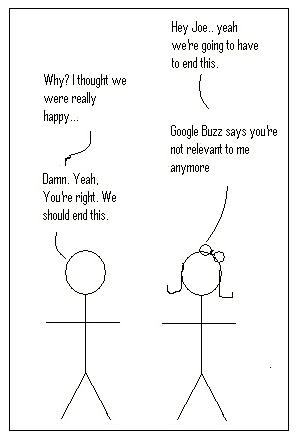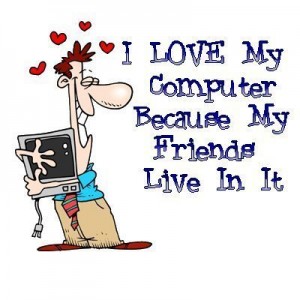- <
 There’s been a whole lot of hub bub on the release of the New Google Buzz. While I think Buzz is generally cool, there are a few things that make me less likely to get on my desk chair at work and scream about how freaking incredible it is to all of my coworkers. One of those things is a a very real fear of doubts to my sanity. I digress.
There’s been a whole lot of hub bub on the release of the New Google Buzz. While I think Buzz is generally cool, there are a few things that make me less likely to get on my desk chair at work and scream about how freaking incredible it is to all of my coworkers. One of those things is a a very real fear of doubts to my sanity. I digress.
Below are 4 basic reasons I am hesitant to buy into the Buzz
1)I don’t want Google making decisions on which relationships are relevant to me.
2) I already have way too much email and do not welcome the additional inflow from Buzz
3) I am weary about how businesses will use and eventually exploit the structure.
4.) Google will now have an aggregate view of my web use across search, email, and social. Right now users do not have a say in how this data is used.
Below I explore each of these concerns more deeply and hopefully shed more light on these concerns. If you don’t read any further you’ve already got my basic thoughts. But read on, trust me it’s worth it.
1.) I don’t want Google deciding who my friends are.
Yesterday I wrote a post about how we need to better define relationships via social media. I thought it would be a one time post, rant a bit, and all would be good. But then, Google Buzz came out and my post became more of a burning issue. In many ways Buzz took the power of social organization and further removed it from the end user. Google chose to leverage machine thinking & advanced algorithms to “decide” who you are closest to. While I think algorithms are pretty much awesome and can do a lot of good to both simplify and organize are lives (hell I have a stats degree) I don’t believe they should ever be a replacement for decisions made my human mood or preference. Read Write Web said it best: “The people that you email and chat with the most may not be your closest friends or the people that you want to share and connect with.“
The reality is we as humans are fickle people. Yes we often have patterns to our overall behavior, but our opinions or perceptions are rarely routine. This makes algorithmic thinking the WRONG approach to friend management. Take an example I mentioned in the comment yesterday: I have a best friend from college, Tracie. We don’t have a ton of time to talk as we live in separate states, with very different jobs, & very different lives. However, we passively engage in each other lives almost daily. I am more likely to read Tracie social output than anyone else’s , however I rarely comment. I save my thoughts & tidbits for when we get a chance to chat via phone or video chat. That’s simply the dynamics of the relationship we have. That said, according to Google’s model I it’s likely I would rarely see content from Tracie.
What I would be more likely to see is content from people I work with. I email them often, chat with them occasionally, and have used social media as means basic communication. Many of you who know me on foursquare may remember the great Foursquare Battle of 2009 between my boss and me for mayorship of our office building. It was brutal. But as much as I love my co-workers, the last thing I want is being encouraged to spend an additional 6 hours outside of work engaging with their content :).
It boils down to this simple point: Google determining my friends for me is a just a little too 1984 for me.
2) I already have way too much email.
Let’s say we get beyond the issues with friend management that Google Buzz introduces. There are still some basic structural concepts to the tool that I am not so keen on. Take for instance that every time someone responds to a post it goes to your email. Great. More email. I am sure I am not the only person here who has an inbox that is as flooded as Jacksonville, Florida during hurricane season. Wading through the mess of emails I get daily is hard, but somewhat manageable. Until, you add buzz. Now on top of all the regular emails I get, I will also get a mother dump of buzz emails. Which guess what-don’t seem to easily be sorted out. JOY! Now I have 3x as many emails! Just what I wanted for Christmas (Chanukah, Kwanza, Festivus)
Better yet, along with my ability to manage email also goes my favorite excuse. I’m sorry I must have missed that on [insert social site]. Now there are no excuses. Perhaps I am being entirely lazy, but really with all the stuff floating around the Internet I enjoy an excuse to miss some of it. I value my ability to have a reason to take a break and breathe. Now, I have no excuse because it’s in my email. Even if you didn’t stream into email via buzz for the myriad of reasons it may not, people are going to think it’s there. You’re responsible for seeing it. We all know that the whole “it must not have come through” excuse only works once, maybe twice.
Plus, you have a whole new flood of people discovering your email address. Now they too can send you emails about stuff you don’t care about! I know I sound like the worst person ever but really, there is a reason why some people do not have my email address. The main reason is I like to keep my email load manageable and adding every person I have a social relationship would make that pretty much impossible.
Simply put: I like to keep my email and my social community separate and enjoy the perks of doing so.
3) I am weary about how businesses will exploit Buzz.
Call me a skeptic. But I am not sure Google is always going to use recommended posts in the right way. I want to believe that posts will rely on relevant user content that may be of interest to the end user, but I see this easily becoming another method to serve ads. So now, not only will I have ads at the top of my email ( based on the content of my emails- if you didn’t know already), I will also have ads flooding into my buzz stream.
If I accidentally respond to one of the ad buzzes- we are all prone to make mistakes especially when advertising is masked as genuine digital interaction- does that give marketers the ability to hit me with “buzz” driven email? How does that comply with opt out emails policies? How will we be able to block corporate buzz communications? Unlike twitter where I can just unfollow, it’s a little less clear how the role of companies & their ability to contact you through buzz will play out.
For example I might want to extend email privileges to Papa John’s, but I avoid following them on social sites. But since they have my email contact does that automatically give them buzz access? Additionally, let’s say I order pizza a lot. Hence I get a lot of confirmation emails & promotional offers, does that mean they can legitimately (according to buzz’s algorithms) move into my top friend posts? When you mix the world of social and email things get fishy.
My thoughts: Companies will always find a way to advertise and I am concerned Buzz’s methods might be more intrusive than other social sites.
4. That’s a hell of a lot of free data I’d be giving Google. What do I get in return?
Look lets face it Google already knows a lot about me. They know what I search. They know what I email and chat about. The only thing they don’t know is what content socially I share, what my identity is across sites, and who are my greatest influencers. Sure those sounds like some big holes to fill, but if I aggregate everything through Google Buzz, suddenly they now have that very information [in part]. I’ve written a lot about online identity and I think it’s a really important subject in regards to Buzz.
With Buzz moving to include data from other social sites in their stream, such as twitter, flicker, and surely other sites in the coming weeks, we have to firmly begin to examine the value of our data. Privacy is an interesting issue online, because I feel people haven’t been burned enough yet to really see how little control they have of their personal data. With Buzz, Google is officially beginning to manage one identity across sites. Instead of simply managing the connections into site (like oauth), Buzz pulls content & creates an aggregated user record. Ta Da! Your search, email, blog, social, & other data are now in one magically packaged personal file. Are you comfortable having all the data packaged up with no rights in how it is used? I can only speak for myself, but it makes me feel extremely uncomfortable.
We share a ton of information online, but as we approach consumer data aggregation we need to make sure we understand the power in that data. I would love advertisers to be able to provide me relevant offers. But, I don’t want those offers at the expense of intrusion into my personal life. I feel, as many people do right now, that there are too few guidelines on who owns users’ data. Personally I am not confident that Google is who I want to bank on for my identity management. Do I trust they guard their data well? Yes. Do I have confidence in their technology? Yes. Do I think they value my say in my online personal safety and identity control? No. Until I am given the right to limit what information I share with businesses, I am very wary to submit my information cross-sites to identity an aggregation system.
Bottom Line: I want to know I can trust the Company that manages my aggregated online data.
 ecret. I once tried out and was pretty much cast for a reality TV show. Actually, I turned down the opportunity just before the final cast was announced. When I tell people this story, I get one of two reactions. Some of my friends are entirely appalled/surprised that I would even consider something like reality TV. The other half of my friends are bitter I didn’t do it. Even with two entirely different views on the situation, I have only on response: I believe reality TV is a product of several theoretical equations. I wanted to prove my point through anthropological immersion. Plus, its a helluva story.
ecret. I once tried out and was pretty much cast for a reality TV show. Actually, I turned down the opportunity just before the final cast was announced. When I tell people this story, I get one of two reactions. Some of my friends are entirely appalled/surprised that I would even consider something like reality TV. The other half of my friends are bitter I didn’t do it. Even with two entirely different views on the situation, I have only on response: I believe reality TV is a product of several theoretical equations. I wanted to prove my point through anthropological immersion. Plus, its a helluva story.

 ) and Alice is a uber elite social media guru. And to drive this story forward let’s say I am refused service at McDonald’s because I want to order a happy meal & I am not a child. Remember this is all hypothetical. If I get pissed off and write a blog post on my experience and & it’s valid issue, Alice might go to bat for me and spread the message. So while up until this point I am not measurably “influential”- all the sudden, without warning, the story spreads. Why? Because there was no way to predict digitally I was connected to Alice or further more that she would go to bat for me. Proof that, in general, online conversation is not predictable (yet).
) and Alice is a uber elite social media guru. And to drive this story forward let’s say I am refused service at McDonald’s because I want to order a happy meal & I am not a child. Remember this is all hypothetical. If I get pissed off and write a blog post on my experience and & it’s valid issue, Alice might go to bat for me and spread the message. So while up until this point I am not measurably “influential”- all the sudden, without warning, the story spreads. Why? Because there was no way to predict digitally I was connected to Alice or further more that she would go to bat for me. Proof that, in general, online conversation is not predictable (yet).


Southwest fails to moderate hate speech comments
So even if your blind, deaf, & dumb you’ve heard about the Kevin Smith Southwest airline incident. I am NOT going to rehash or add my commentary on whether what Southwest did was right or wrong or whether Kevin Smith is really that fat. Not important. What is important is the comments Southwest has allowed to be post on their blog.
A small sample- You can read all of them here & here:
Hate speech is defined as ” speech perceived to disparage a person or group of people based on their social or ethnic group”. I am pretty sure these comments fall hard in the line of hate speech and thus extremely inappropriate for a brand to be hosting on their site. No brand wants to be seen as a conduit of any type of bigotry. Ever. But low & behold Southwest is hosting a conversation spewing with lil’ pieces of hate on every page. I am frankly shocked none of these comments were removed during moderation. I thought that maybe Southwest had made a big boo boo and no installed a moderation system into their blog.
But shock & awe Southwest’s blog user guidelines state:
“This is the point where we insert the “fine print” and discuss the guidelines for posting. Nuts About Southwest is a moderated site because we want to ensure that everyone stays on topic—or at least pretty close to it. We would LUV for you to post your thoughts, comments, suggestions, and questions, but when you post, make sure that they are of general interest to most readers. Of course, profanity, racial and ethnic slurs, and rude behavior like disparaging personal remarks won’t be tolerated nor published.”
So. Wait. Really? Southwest does enforce comment moderation? Sure doesn’t seem like it. I am pretty damn sure that last time I checked saying something like, “To be honest, I would not want to sit next to a fatty on an airplane. They smell and overflow into my seat.” was pretty damn rude. Plus something like “I can’t stand fat ass people,” counts as profanity, no?
People are entitled to their opinion, and agree Southwest needs to allow people to add their two cents. But, I am clearly shocked by how loose they have been with comment moderation. It’s not like people who agree with Southwest’s perspective can’t share without using profanity and degrading comments against fat people. I happen to think this comment is written well with out being offensive or profane:
“As for the others who are offended by the policy – why should the rest of us pay for your inability to get fit? Working on it? Bravo to you! Until you get there, though, pay for the extra seat or drive. Southwest has always had the best service, best prices, and best flight attendants! My family will remain loyal customers.”
After reading this and really thinking about it I have decided to not fly Southwest. Is it because of Kevin Smith? Not directly. Is it because Southwest on their own blog has gone against their corporate policy and allowed hateful comments to remain posted on the site? YES! In essence, by not removing these they impart have ignored the hurtful and awful nature of these statements. I don’t ask for much of brands, just that in a public forum, they stick to their legal responsibility & refrain from supporting or posting hate speech. I am sorry Southwest you broke that rule.
Also, Southwest just an FYI You might want to take those comments down because according to your legal disclaimer & the nature of comments that made it through your filter -you could be sued. Or you can hope, just like one of your commentors, that ” [fat people] just stay home till they have shed the pounds and can join the human race.”